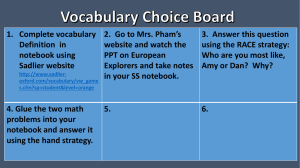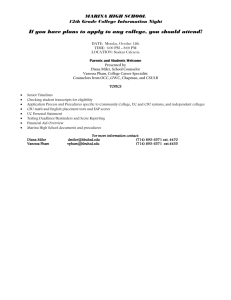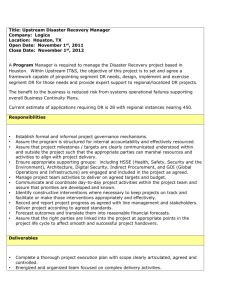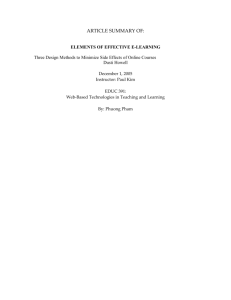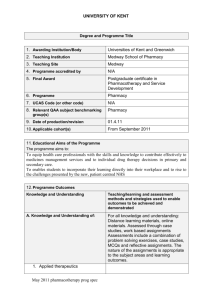Programmable Reinforcement Learning Agents Abstract
advertisement
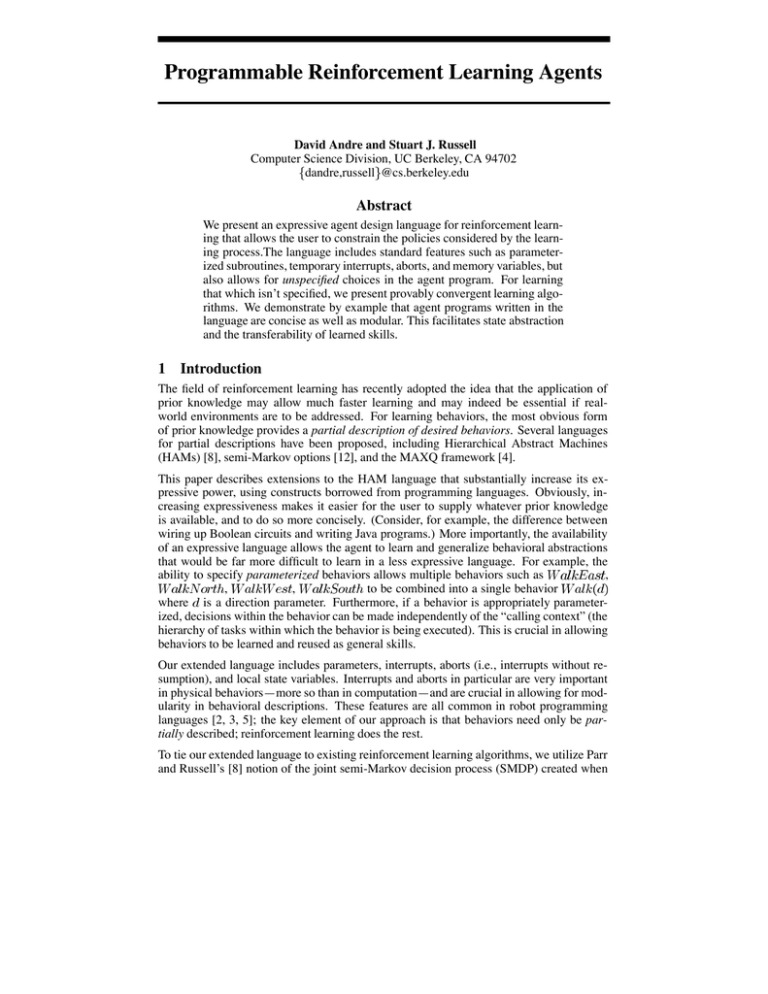
Programmable Reinforcement Learning Agents
David Andre and Stuart J. Russell
Computer Science Division, UC Berkeley, CA 94702
dandre,russell @cs.berkeley.edu
Abstract
We present an expressive agent design language for reinforcement learning that allows the user to constrain the policies considered by the learning process.The language includes standard features such as parameterized subroutines, temporary interrupts, aborts, and memory variables, but
also allows for unspecified choices in the agent program. For learning
that which isn’t specified, we present provably convergent learning algorithms. We demonstrate by example that agent programs written in the
language are concise as well as modular. This facilitates state abstraction
and the transferability of learned skills.
1 Introduction
The field of reinforcement learning has recently adopted the idea that the application of
prior knowledge may allow much faster learning and may indeed be essential if realworld environments are to be addressed. For learning behaviors, the most obvious form
of prior knowledge provides a partial description of desired behaviors. Several languages
for partial descriptions have been proposed, including Hierarchical Abstract Machines
(HAMs) [8], semi-Markov options [12], and the MAXQ framework [4].
This paper describes extensions to the HAM language that substantially increase its expressive power, using constructs borrowed from programming languages. Obviously, increasing expressiveness makes it easier for the user to supply whatever prior knowledge
is available, and to do so more concisely. (Consider, for example, the difference between
wiring up Boolean circuits and writing Java programs.) More importantly, the availability
of an expressive language allows the agent to learn and generalize behavioral abstractions
that would be far more difficult to learn in a less expressive language. For example, the
ability to specify parameterized behaviors allows multiple behaviors such as
,
,
,
to be combined into a single behavior
where is a direction parameter. Furthermore, if a behavior is appropriately parameterized, decisions within the behavior can be made independently of the “calling context” (the
hierarchy of tasks within which the behavior is being executed). This is crucial in allowing
behaviors to be learned and reused as general skills.
Our extended language includes parameters, interrupts, aborts (i.e., interrupts without resumption), and local state variables. Interrupts and aborts in particular are very important
in physical behaviors—more so than in computation—and are crucial in allowing for modularity in behavioral descriptions. These features are all common in robot programming
languages [2, 3, 5]; the key element of our approach is that behaviors need only be partially described; reinforcement learning does the rest.
To tie our extended language to existing reinforcement learning algorithms, we utilize Parr
and Russell’s [8] notion of the joint semi-Markov decision process (SMDP) created when
a HAM is composed with an environment (modeled as an MDP). The joint SMDP state
space consists of the cross-product of the machine states in the HAM and the states in the
original MDP; the dynamics are created by the application of the HAM in the MDP. Parr
and Russell showed that an optimal solution to the joint SMDP is both learnable and yields
an optimal solution to the original MDP in the class of policies expressed by the HAM (socalled hierarchical optimality). Furthermore, Parr and Russell show that the joint SMDP
can be reduced to an equivalent SMDP with a state space consisting only of the states
where the HAM does not specify an action, which reduces the complexity of the SMDP
problem that must be solved. We show that these results hold for our extended language of
Programmable HAMs (PHAMs).
To demonstrate the usefulness of the new language, we show a small, complete program for
a complex environment that would require a much larger program in previous formalisms.
We also show experimental results verifying the convergence of the learning process for
our language.
2 Background
An MDP is a 4-tuple,
, where is a set of states, is a set of actions, is a
probabilistic transition function mapping
, and is a reward function
mapping
to the reals. In this paper, we focus on infinite-horizon MDPs with a
discount factor . A solution to a MDP is an optimal policy
that maps from
and
achieves maximum expected discounted reward for the agent. An SMDP (semi-Markov
decision process) allows for actions that take more than one time step.
is modified to
be a mapping from
, where is the natural numbers; i.e., it specifies
a distribution over both output states and action durations.
is then a mapping from
to the reals. The discount factor, , is generalized to be a function,
, that
represents the expected discount factor when action is taken in state . Our definitions
follow those common in the literature [9, 6, 4].
The HAM language [8] provides for partial specification of agent programs. A HAM program consists of a set of partially specified Moore machines. Transitions in each machine
may depend stochastically on (features of) the environment state, and the outputs of each
machine are primitive actions or nonrecursive invocations of other machines. The states
in each machine can be of four types: start, stop, action, choice . Each machine has a
single distinguished start state and may have one or more distinguished stop states. When
a machine is invoked, control starts at the start state; stop states return control back to the
calling machine. An action state executes an action. A call state invokes another machine
as a subroutine. A choice state may have several possible next states; after learning, the
choice is reduced to a single next state.
3 Programmable HAMs
Consider the problem of creating a HAM program for the Deliver–Patrol domain presented
in Figure 1, which has 38,400 states. In addition to delivering mail and picking up occasional additional rewards while patrolling (both of which require efficient navigation and
safe maneuvering), the robot must keep its battery charged (lest it be stranded) and its
camera lens clean (lest it crash). It must also decide whether to move quickly (incurring
collision risk) or slowly (delaying reward), depending on circumstances.
Because all the
“rooms” are similar, one can write a “traverse the room” HAM routine
that works in all rooms, but a different routine is needed for each direction (north–south,
south–north, east–west, etc.). Such redundancy suggests the need for a “traverse the room”
routine that is parameterized by the desired direction.
Consider also the fact that the robot should clean its camera lens whenever it gets dirty.
Root()
A
DoAll
B
Clean
water
R
Patrol
mail
DoDelivery
Work()
DoDelivery()
set z2 = z1
M
Nav(M,{s,f})
Nav(mdest,{s,f})
getMail
delMail
C
D
Nav(z2,{s,f})
(b)
set z1 = z2
(a)
Figure 1: (a) The Deliver–Patrol world. Mail appears at
and must be delivered to the appropriate location. Additional rewards appear sporadically at , , , and . The robot’s battery
may be recharged at . The robot is penalized for colliding with walls and “furniture” (small circles). (b) Three of the PHAMs in the partial specification for the Deliver–Patrol world. Right-facing
half-circles are start states, left-facing half-circles are stop states, hexagons are call states, ovals are
and are memory variables. When arguments to
primitive actions, and squares are choice points.
call states are in braces, then the choice is over the arguments to pass to the subroutine. The
PHAM specifies an interrupt to clean the camera lens whenever it gets dirty; the
PHAM
interrupts its patrolling whenever there is mail to be delivered.
ToDoor(dest,sp)
p()
(a)
N
E
S
W
fN
fE
fS
fW
Move(dir)
dir=N
dir=E
else
dir=S
noop
dir=W
N
E
S
W
~At(dest)
(b)
Figure 2: (a) A room in the Deliver–Patrol domain. The arrows in the drawing of the room inditransition function in ToDoor(dest,sp). Two arrows indicate
cate the behavior specified by the
a “fast” move (fN,fS,fE.fW), whereas a single arrow indicates a slow move (N, S, E, W). (b) The
ToDoor(dest,sp) and Move(dir) PHAMs.
Nav(dest,sp)
Nav( {A,B,C,D},sp)
else
ToDoor({N, E, S, W},sp)
~InRoom(dest)
Patrol()
Nav( {A,B,C,D},{s,f})
NavRoom(dest,speed)
ToDoor(dest,speed)
Move(dest)
DoAll()
bat
detach
else
~thruDoor
~bat
charge
work
~bat
ToDoor(N,s)
nav(R,f)
Figure 3: The remainder of the PHAMs for the Deliver–Patrol domain. Nav(dest,sp) leaves route
choices to be learned through experience. Similarly, Patrol() does not specify the sequence of locations to check.
In the HAM language, this conditional action must be inserted after every state in every
HAM. An interrupt mechanism with appropriate scoping would obviate the need for such
widespread mutilation.
The PHAM language has these additional characteristics. We provide here an informal
summary of the language features that enable concise agent programs to be written. The
9 PHAMs for the Deliver–Patrol domain are presented in Figure 1(b), Figure 2(b), and
Figure 3. The corresponding HAM program requires 63 machines, many of which have
significantly more states than their PHAM counterparts.
The PHAM language adds several structured programming constructs to the HAM language. To enable this, we introduce two additional types of states in the PHAM: internal
states, which execute an internal computational action (such as setting memory variables
to a function of the current state), and null states, which have no direct effect and are used
for computational convenience.
Parameterization is key for expressing concise agent specifications, as can be seen in
the Deliver–Patrol task. Subroutines take a number of parameters,
, the values of which must be filled in by the calling subroutine (and can depend on any function
of the machine, parameter, memory, and environment state). In Figure 2(b), the subroutine Move(dir) is shown. The dir parameter is supplied by the NavRoom subroutine. The
ToDoor(dest,speed) subroutine is for navigating a single room of the agent’s building. The
is a transition function that stores a parameterized policy for getting to each door. The
policy for
(representing the North door, going fast) is shown in Figure 2(a). Note
that by using parameters, the control for navigating a room is quite modular, and is written
once, instead of once for each direction and speed.
Aborts and interrupts allow for modular agent specification. As well as the camera-lens
interrupt described earlier, the robot needs to abort its current activity if the battery is low
and should interrupt its patrolling activity if mail arrives for delivery. The PHAM language
allows abort conditions to be specified at the point where a subroutine is invoked within
a calling routine; those conditions are in force until the subroutine exits. For each abort
condition, an “abort handler” state is specified within the calling routine, to which control
returns if the condition becomes true. (For interrupts, normal execution is resumed once
the handler completes.) Graphically, aborts are depicted as labelled dotted lines (e.g., in the
DoAll() PHAM in Figure 3), and interrupts are shown as labelled dashed lines with arrows
on both ends (e.g., in the Work() PHAM in Figure 1(b)).
Memory variables are a feature of nearly every programming language. Some previous
research has been done on using memory variables in reinforcement learning in partially
observable domains [10]. For an example of memory use in our language, examine the
DoDelivery subroutine in Figure 1(b), where
is set to another memory value (set in
Nav(dest,sp)).
is then passed as a variable to the Nav subroutine. Computational functions such as dest in the Nav(dest,sp) subroutine are restricted to be recursive functions
taking effectively zero time. A PHAM is assumed to have a finite number of memory variables,
, which can be combined to yield the memory state, . Each memory
variable has finite domain
. The agent can set memory variables by using internal
states, which are computational action states with actions in the following format: (set
), where
is a function taking the machine, parameter, environment, and memory state as parameters. The transition function, parameter-setting
functions, and choice functions take the memory state into account as well.
4 Theoretical Results
Our results mirror those obtained in [9]. In summary (see also Figure 4): The composition
of a PHAM with the underlying MDP
is defined using the cross product of
states in and . This composition is in fact an SMDP. Furthermore, solutions to
yield optimal policies for the original MDP, among those policies expressed by the PHAM.
Finally,
may be reduced to an equivalent SMDP whose states are just the choice
points, i.e., the joint states where the machine state is a choice state. See [1] for the proofs.
Definition 1 (Programmable Hierarchical Abstract Machines: PHAMs) A PHAM is a
tuple
, where is the set of machine states in ,
is the space of possible parameter settings, is the transition function, mapping
to
, is a mapping from
to
and expresses the
parameter choice function, maps from
to subsets of and expresses the
returns the interrupt condition at a call state,
allowed choices at choice states,
specifies the handler of an interrupt,
returns the abort condition at a call state,
specifies the handler of an abort, is the set of possible memory configurations,
is a complex function expressing which computational internal function is used
and
at internal states, and to which memory variable the result is assigned.
Theorem 1 For any MDP,
and any PHAM, , the operation of in
induces a joint
. If is an optimal solution for
, then the primitive actions
SMDP, called
specified by constitute an optimal policy for
among those consistent with .
may be enormous. As is illustrated in Figure 4, however, we
The state space of
can obtain significant further savings, just as in [9]. First, not all pairs of PHAM and MDP
states will be reachable from the initial state; second, the complexity of the induced SMDP
is solely determined by the number of reachable choice points.
Theorem 2 For any MDP
and PHAM , let be the set of choice points in
.
) with states such that the optimal policy for
There exists an SMDP called reduce(
) corresponds to an optimal policy for
among those consistent with .
reduce(
The reduced SMDP can be solved by offline, model-based techniques using the method
given in [9] for constructing the reduced model. Alternatively, and much more simply,
we can solve it using online, model-free HAMQ-learning [8], which learns directly in the
reduced state space of choice points. Starting from a choice state where the agent takes
action , the agent keeps track of the reward
and discount
accumulated on the way
to the next choice point, . On each step, the agent encounters reward
and discount
(note that
is 0 exactly when the agent transitions only in the PHAM and not in the
MDP), and updates the totals as follows:
The agent maintains a Q-table,
agent gets to the next choice state,
, indexed by choice state and action. When the
, it updates the Q-table as follows:
We have the following theorem.
, HAMQ-learning will converge to an opTheorem 3 For a PHAM and and MDP
, with probability 1, with appropriate restrictions on the
timal policy for reduce
learning rate.
5 Expressiveness of the PHAM language
As shown by Parr [9], the HAM language is at least as expressive as some existing action
languages including options [12] and full- models [11]. The PHAM language is substantially more expressive than HAMs. As mentioned earlier, the Deliver–Patrol PHAM
program has 9 machines whereas the HAM program requires 63. In general, the additional
number of states required to express a PHAM as a pure HAM is
, where
is the memory state space, is the set of possible abort/interrupt contexts, and is
the total parameter space. We also developed a PHAM program for the 3,700-state maze
world used by Parr and Russell [8]. The HAM used in their experiments had 37 machines;
the PHAM program requires only 7.
1
b
2
1
c
1
d
c
3
a
MDP M
PHAM H
c
c
1
4
3
4
c
2
c
3
c
4
a
b
1
1
d
1
a
b
a
b
2
2
d
2
3
3
d
3
a
b
4
4
d
4
Reduce(H M)
2
Joint SMDP (H M)
Figure 4: A schematic illustration of the formal results. (1) The top two diagrams are of a PHAM
fragment with 1 choice state and 3 action states (of which one, labelled , is the start state). The
, is shown in
MDP has 4 states, and action always leads to state or . The composition,
or
. In (3), reduce(
) is
(2). Note that there are no incoming arcs to the states
shown. There are only 2 states in the reduced SMDP because there are no incoming arcs to the states
or
.
Results on Deliver/Patrol Task
150000
Score (Average of 10 5000 step runs)
100000
50000
0
optimal
PHAM-easy
PHAM-hard
Q-Learning
-50000
-100000
-150000
0
50
100
Num Primitive Steps, in 10,000s
150
200
Figure 5: Learning curves for the Deliver/Patrol domain, averaged over 25 runs. X-axis: number of
primitive steps. Y-axis: value of the policy measured by ten 5,000 step trials. PHAM-hard refers to
the PHAMs given in this paper. PHAM-easy refers to a more complete PHAM, leaving unspecified
only the speed of travel for each activity.
With respect to the induced choice points, the Deliver–Patrol PHAM induces 7,816 choice
points in the joint SMDP, compared with 38,400 in the original MDP. Furthermore, only
15,800 Q-values must be learned, compared with 307,200 for flat Q-learning. Figure 5
shows empirical results for the Deliver–Patrol problem, indicating that Q-learning with a
suitable PHAM program is far faster than flat Q-learning. (Parr and Russell observed similar results for the maze world, where HAMQ-learning finds a good policy in 270,000 iterations compared to 9,000,000 for flat Q-learning.) Note that equivalent HAM and PHAM
programs yield identical reductions in the number of choice points and identical speedups
in Q-learning. Thus, one might argue that PHAMs do not offer any advantage over HAMs,
as they can express the same set of behaviors. However, this would be akin to arguing that
the Java programming language offers nothing over Boolean circuits. Ease of expression
and the ability to utilize greater modularity can greatly ease the task of coding reinforcement learning agents that take advantage of prior knowledge.
An interesting feature of PHAMs was observed in the Deliver–Patrol domain. The initial
PHAM program was constructed on the assumption that the agent should patrol among ,
, , unless there is mail to be delivered. However, the specific rewards are such that
the optimal behavior is to loiter in the mail room until mail arrives, thereby avoiding costly
delays in mail delivery. The PHAM-Q learning agents learned this optimal behavior by
“retargeting” the
routine to stay in the mail room rather than go to the specified destination. This example demonstrates the difference between constraining behavior through
structure and constraining behavior through subgoals: the former method may give the
agent greater flexibility but may yield “surprising” results. In another experiment, we constrained the PHAM further to prevent loitering. As expected, the agent learned a suboptimal
policy in which
had the intended meaning of travelling to a specified destination. This
experience suggests a natural debugging cycle in which the agent designer may examine
learned behaviors and adjust the PHAM program accordingly.
The additional features of the PHAM language allow direct expression of programs from
other formalisms that are not easily expressed using HAMs. For example, programs in
Dietterich’s MAXQ language [4] are written easily as PHAMs, but not as HAMs because
the MAXQ language allows parameters. The language of teleo-reactive (TR) programs [7,
2] relies on a prioritized set of condition–action rules to achieve a goal. Each action can
itself be another TR program. The TR architecture can be implemented directly in PHAMs
using the abort mechanism [1].
6 Future work
Our long-term goal in this project is to enable true cross-task learning of skilled behavior.
This requires state abstraction in order to learn choices within PHAMs that are applicable
in large classes of circumstances rather than just to each invocation instance separately.
Dietterich [4] has derived conditions under which state abstraction can be done within his
MAXQ framework without sacrificing recursive optimality (a weaker form of optimality
than hierarchical optimality). We have developed a similar set of conditions, based on a
new form of value function decomposition, such that PHAM learning maintains hierarchical optimality. This decomposition critically depends on the modularity of the programs
introduced by the language extensions presented in this paper.
Recently, we have added recursion and complex data structures to the PHAM language,
incorporating it into a standard programming language (Lisp). This provides the PHAM
programmer with a very powerful set of tools for creating adaptive agents.
References
[1] D. Andre. Programmable HAMs. www.cs.berkeley.edu/˜dandre/pham.ps, 2000.
[2] S. Benson and N. Nilsson. Reacting, planning and learning in an autonomous agent. In K. Furukawa, D. Michie, and S. Muggleton, editors, Machine Intelligence 14. 1995.
[3] G. Berry and G. Gonthier. The Esterel synchronous programming language: Design, semantics,
implementation. Science of Computer Programming, 19(2):87–152, 1992.
[4] T. G. Dietterich. State abstraction in MAXQ hierarchical RL. In NIPS 12, 2000.
[5] R.J. Firby. Modularity issues in reactive planning. In AIPS 96, pages 78–85. AAAI Press, 1996.
[6] L. P. Kaelbling, M. L. Littman, and A. W. Moore. Reinforcement learning: A survey. JAIR,
4:237–285, 1996.
[7] N. J. Nilsson. Teleo-reactive programs for agent control. JAIR, 1:139–158, 1994.
[8] R. Parr and S. J. Russell. Reinforcement learning with hierarchies of machines. In NIPS 10,
1998.
[9] R. Parr. Hierarchical Control and Learning for MDPs. PhD thesis, UC Berkeley, 1998.
[10] L. Peshkin, N. Meuleau, and L. Kaelbling. Learning policies with external memory. In ICML,
1999.
[11] R. Sutton. Temporal abstraction in reinforcement learning. In ICML, 1995.
[12] R. Sutton, D. Precup, and S. Singh. Between MDPs and semi-MDPs: A framework for temporal
abstraction in reinforcement learning. Artificial Intelligence, 112(1):181–211, February 1999.
